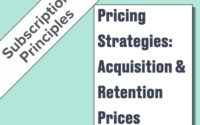Manual Renewal : the plan B when automatic renewal fails
A subscription is generally defined as a contract for the acquisition of a regular service for an indefinite period in exchange for regular payments. Automatic renewal ensures regular payments.
If automatic renewal fails, an alternative flow can keep customers subscribed. Let’s explore the use cases and risks associated with such a procedure.
1. The Use Cases
As long as automatic renewal works, no other renewal procedure is necessary. However, when automatic renewal doesn’t, an alternative solution must be provided for customers who wish to remain subscribed.
Since maintaining the subscription is conditional upon payment, all that is required, is a payment procedure.
a. Invalid Billing Profile
Failed billing often results from outdated details. For example, the debit card on file is expired.
b. The payment method is not auto-renewable
It’s possible the e-commerce site where the initial purchase took place offered payment methods that did not allow automatic renewal, such as bank transfer.
c. The customer “is owned” by someone else
If sold by a reseller, the reseller “owns” the customer. If the customer wishes to keep their subscription running without going through the reseller, they will need to give their consent for automatic renewal. From the subscriber’s point of view, this is a renewal; for the merchant, it’s a transfer from an indirect channel to a direct one.
d. The subscription has expired
After the subscription expires, the commercial relationship between the subscriber and the merchant ends. The merchant has no reason to proceed any further payment attempts. However, in a last message to the subscriber, it’s possible to invite them to renew themselves and thus resume the subscription.
e. The customer has unsubscribed
Since the subscriber has voluntarily terminated the automatic renewal, the merchant will attempt to:
- Either get the customer’s consent for a renewal
- Or have them purchase a new subscription
2. The 2 solutions
These cases boil down to these essential needs: obtaining the subscriber’s consent for the renewal and/or an updated billing profile. There are two ways to achieve this goal:
a. Updating the Billing Profile
The customer is asked to choose a payment method and provide the necessary information. Immediately after providing the information, a billing attempt occurs. If successful, the subscription is resumed.
This procedure is preferred in cases where:
- we already have the customer’s consent for automatic renewal
- we only offer auto-renewable payment methods
b. Acquisition-style renewal
The customer is invited to purchase a new subscription, but presented as a renewal. The acquisition channel purchase experience is used.
This procedure is preferred in cases where:
- we don’t yet have the customer’s consent for automatic renewal
- we want to offer non-automatic payment methods
3. The risks created by “acquisition-style” renewal flow
a. Losing the customer
Any renewal flow that is not initiated by the merchant (i.e. non-automatic) increases the risk of churn. Indeed, renewal is conditional on the customer’s action, whose success depends on:
- The user interface, its ergonomics
- The payment methods offered
- The renewal price, since it’s highly visible in this flow
b. Creating a parallel “non-subscription” business
Non-automatic payment methods are last-resort solutions for retaining loyal subscribers who don’t have access to any other payment methods.
By offering such options, a “non-subscription” business is created. Consequently, it’s wise to slightly modify the offer so that customers subject to the constraint of automatic renewal do not feel disadvantaged.
c. Creating a Win-Back Channel
If manual renewal is used as a “win-back” channel with very aggressive pricing, then a parallel low-cost channel is created. A regulator would see this as a channel where the least loyal customers receive the best prices. Consequently, loyal customers are punished with a higher price.
👉 Key Takeaways 👈
- It’s crucial to plan for a way to recover customers who could not be renewed automatically.
- Some use cases can be addressed well before the first charge attempt. 📅
- The billing profile update procedure 💵 is crucial. The flow must be monitored and its user interface optimized.



